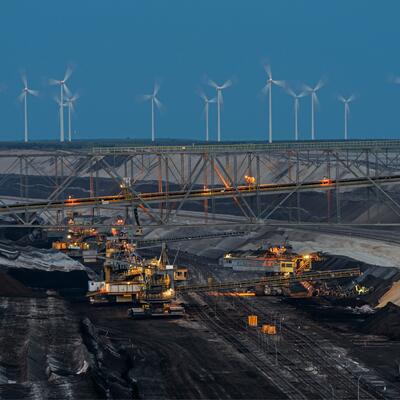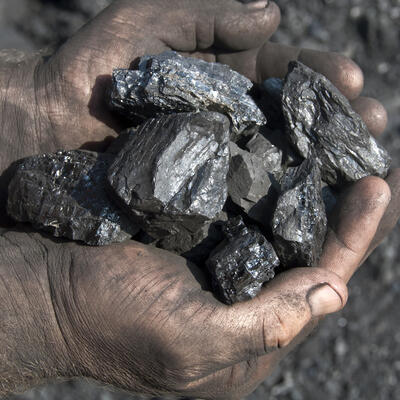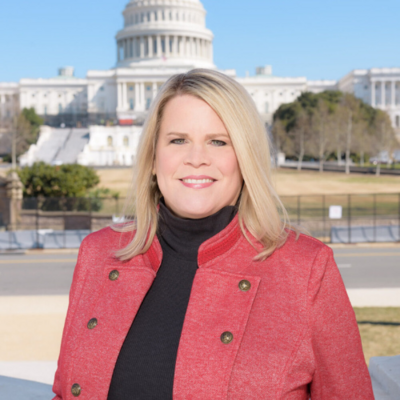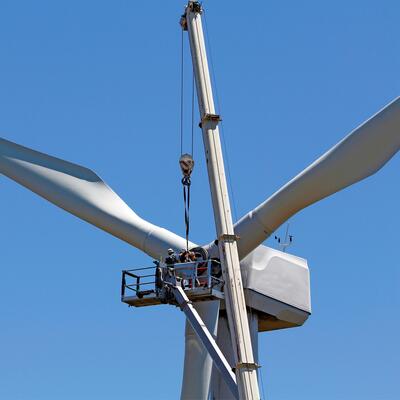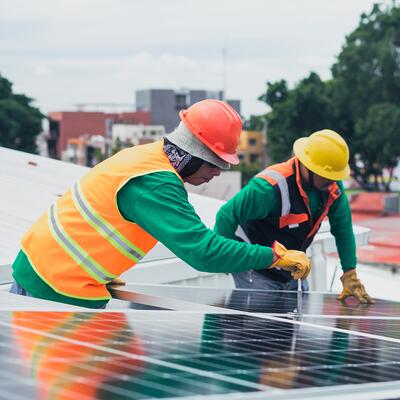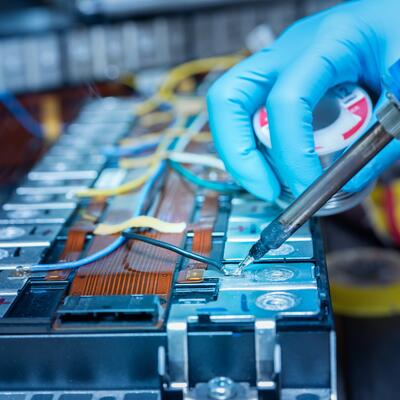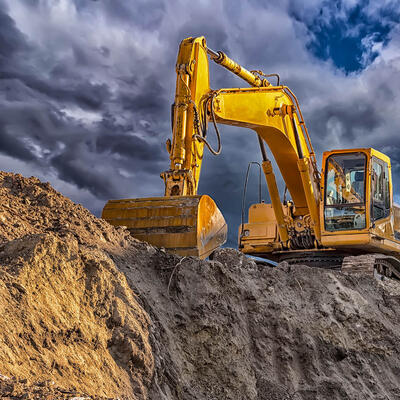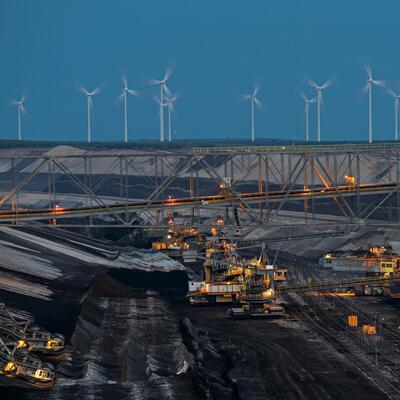
Transfer of Power: Life After Coal
Guests
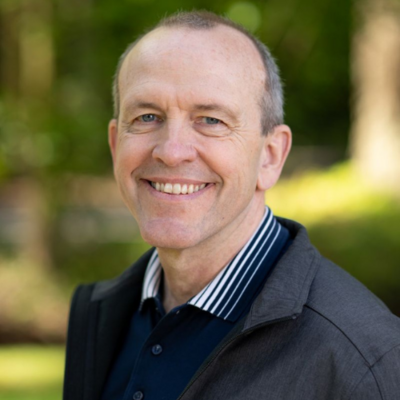
Chris Levesque
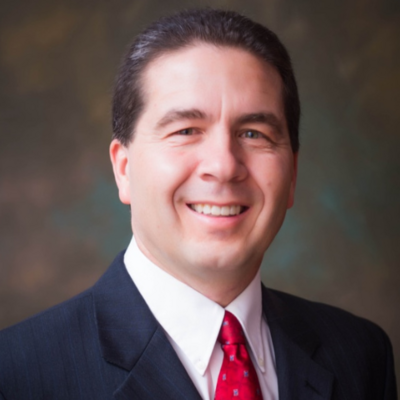
Brian Muir
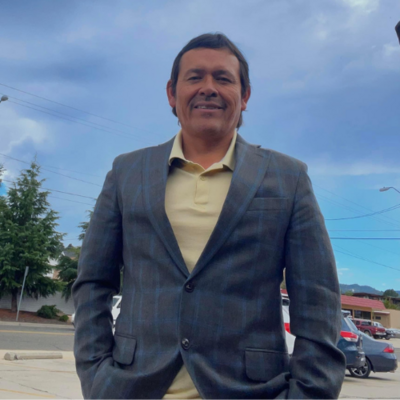
Tony Skrelunas
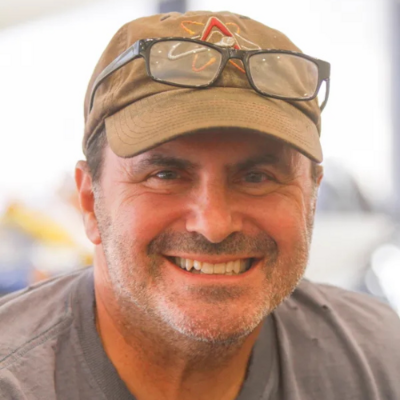
Mike Eisenfeld
Summary
For more than a century, coal powered much of the U.S. Now it's on its way out. That means all across the country, the communities that were built on coal are facing a big change.
From a climate and health standpoint, the choice is easy. Burning coal is a major source of the greenhouse gases driving global warming. Mining and burning coal also pollutes the air and water, and it contributes to tens of thousands of deaths per year.
And economically, in today’s world, electricity from coal is no longer as cheap as wind and solar. Between 2010 and 2019, nearly 300 U.S. coal plants closed. And roughly half of the remaining capacity is set to close by the end of 2030.
At the same time, coal has provided the economic backbone for many rural communities. And we know that when it goes, the hole it leaves behind can be devastating. Livelihoods are destroyed — and thriving communities suddenly empty out.
So is there a way to transition off of coal without sacrificing the people and places connected to it? Today, we’re going to take you to coal communities across the country — places that are going through this transition right now. One of those places is Kemmerer, Wyo., where a coal town in decline has been thrown an economic lifeline from perhaps an unexpected source: tech billionaire and philanthropist Bill Gates. He’s behind TerraPower, a new company working on building a new advanced nuclear reactor in Kemmerer. Even before the plant is constructed the town has already seen an influx of new investment and people.
“It’s an interesting dynamic going on here in Wyoming. It's like a laboratory really of energy change,” says town administrator Brian Muir.
On the Navajo Nation in northern Arizona, the Navajo Generating Station (NGS) and its companion mine shut down in 2019. For decades NGS powered many southwestern cities and employed hundreds of local people with high-wage jobs. Tony Skrelunas is their head of economic development.
“It does hurt to lose something that is a big part of your society and really supports the uplifting of these ways,” he says. “But we're aware that we need to transition.”
In the wake of the closure he and others have been working to diversify the region’s economy. They’re developing a master plan that includes building a $700 million resort project and bringing in solar power. Skrelunas says they're already being approached by several energy companies who want to make use of the old coal infrastructure, like transmission lines.
“We don't want to repeat the past. We don't want people nearby … not have the benefits of what's being generated off of these projects. What are revenues that can be shared with the community? How can you incorporate the families giving up their land? What kind of scholarships can be provided to the children of the local families? So that's really the paradigm shift that is everywhere now.”
Episode Highlights
00:30 – Visit to Kemmerer, Wyoming
06:30 – Coal jobs decline
10:00 – TerraPower seeks to build new nuclear plant in Wyoming
13:30 – TerraPower comes to Kemmerer
16:30 – Skepticism about nuclear power
19:30 – Reemploying coal workers at nuclear plant
22:30 – Economic development and investment follows nuclear plant announcement
28:00 – Visit to Farmington, New Mexico
30:00 – Community support for CCS to extend life of coal plant and mine
33:00 – Coalition advocates for cleanup and just and orderly transition for coal community
36:00 – Farmington rebranding for recreation, tourism
38:00 – Visit to Navajo Nation in Arizona
40:00 – Coal industry paid well, and also contaminated land and air
44:00 – Navajo Nation seeks to diversify economy after closure of coal plants
48:00 – Federal money going to help these energy communities transition
Resources From This Episode (3)
Full Transcript
Ariana Brocious: I’m Ariana Brocious.
Austin Colón: I’m Austin Colón.
Ariana Brocious: And this is Climate One.
[music]
Ariana Brocious: We’re starting today’s show in a small town in Wyoming, called Kemmerer.
Mark Thatcher: It's been good for us. Yes, it's been good for us. We've got four kids. Three of them, they'd all left, but three of them come back to Kemmerer.
Ariana Brocious: Mark Thatcher has lived here for nearly 40 years. The walls of his living room are covered with pictures of his family. Four kids, and lots and lots of grandkids.
Mark Thatcher: I got to meet the class president, the valedictorian, athlete of the year, all in one pretty little granddaughter. So, you know what I mean? Kemmerer's been good for us.
Ariana Brocious: Thatcher came to Kemmerer back in 1988 for a job in the local coal mine. He worked as an electrician and retired just a few years back. In fact, he spent his entire career working in coal.
Mark Thatcher: It might be a little dangerous and it might be a little dirty, but it's a good job and you appreciate it. It's all fine. You know, it's a necessary job.
Ariana Brocious: And it’s a job that allowed him to provide for his family and live comfortably and well. Some 2500 people live here in Kemmerer – it’s a small community where many people know each other. But the industry on which Thatcher built his livelihood – on which the whole town has been built – is coal. And that’s changing.
Austin Colón: You know where this story is going… Burning coal is a major source of the greenhouse gasses driving global warming. Mining and burning coal also pollutes the air and water, and it contributes to tens of thousands of deaths per year.
Plus, in today’s world, electricity from coal is no longer as cheap as wind and solar. And so, as the country transitions to greener energy sources, coal is on its way out. Between 2010 and 2019, nearly 300 US coal plants closed. And roughly half of the remaining capacity is set to close by the end of 2030.
Ariana Brocious: At the same time, coal has provided the economic backbone for many rural communities. And we know that when it goes, the hole it leaves behind can be devastating. Livelihoods are destroyed – and thriving communities suddenly empty out.
Austin Colón: So is there a way to transition off of coal without sacrificing the people and places connected to it? Today, we’re going to take you to coal communities across the country – places that are going through this transition right now –
Ariana Brocious: And we’ll hear from people who are trying to figure out how their towns can stay vibrant… what can be done to prevent their friends and family from being left behind.
[music shift]
Austin Colón: So let’s go to Wyoming…where coal has been king for more than a century.
Mark Thatcher: That's how Kemmerer got here is the surveyor that found the coal, named it after a rich man. And so he supported it.
Austin Colón: The town of Kemmerer is located in Lincoln County, in the southwest corner of the state. I was there in September and the first thing I noticed was the landscape. It’s wide open. I live in Brooklyn and I’ve become quite used to large buildings being nearly on top of each other, so this was a bit of an adjustment. I mean, there's the expansive beauty of the desert. Giant mountains in the distance. The sky is so blue, and not a cloud in sight. Sagebrush lines the roads as far as you can see.
Caitlin Tan: The minute you get out of town, I mean, that's all public land, so you could just like hike wherever you want in the sagebrush out there.
Austin Colón: Wyoming Public Media reporter and producer Caitlin Tan gave me a little tour.
Caitlin Tan: And do whatever you want, pretty much.
[ambient noise]
Austin Colón: The downtown area is what you'd expect a western strip to look like. Low-slung buildings line each side of the wide road. Some storefronts are empty and run down. And then there are new stores that wouldn’t look out of place in hipster Brooklyn.
Two things you see everywhere: Dust, which is kicked up by the pick-up trucks rolling down the main road. And signs advertising fossils.
Caitlin Tan: Okay, so here's a sign, fossil capital of the world.
Austin Colón: There's Fossil Country Frontier Museum and Bob's Rock Shop. I stayed at the Fossil Butte Motel. Even the coffee shop in town is called Fossil Fuel Coffee Company! This town loves fossils.
Caitlin Tan: Here's a little fossil shop. Tynsky's Fossils.
Austin Colón: Tynsky's Fossils is one of several places where you can buy actual fossils in Kemmerer. It's run by Kodi Tynsky, and it's been in her family for generations.
Kodi Tynsky: So this is called, this is a diplomystus. It's one of the most common fish in, that was in the lake. This, these are nidias, they're called nidias. Um, this is a Prisca Cara. Another diplomystus.
Austin Colón: These are fossils found right here in Kemmerer. And the same geologic processes that fossilized plants and animals from eons ago, also made this area rich in coal.
Brian Muir: The coal mine is the biggest employer, 215 employees.
Austin Colón: This is Brian Muir, Kemmerer city administrator.
Brian Muir: Another big employer of course is the power plant, has about 109 full time employees. And then, another employer that's big here is ExxonMobil, Exxon Mobil has about over 200 employees. And, so, those are the big economic engines of our community.
Austin Colón: Economic engines that help fund things like schools, libraries, and the fire department.
But that’s changing. In 2019, the coal plant in Kemmerer announced it might be shutting down.
Brian Muir: You know, not too much after I got here, that's when they did actually shut down number three, Naughton number three, which dramatically affected the coal jobs. They'd already been in decline.
Austin Colón: When he says Naughton number three, he’s talking about one of the three units at the plant. They ended up converting that one to natural gas. But the entire plant still plans to shut down by 2036. And it gets its coal from a local mine. So when the plant closes, the mine will either have to find a new buyer, or it will close too. And that’s got people worried. Like retired coal worker Mark Thatcher.
Mark Thatcher: Coal mine, the power plant, there's a lot of good paying jobs that if you want to have a gas station, a grocery store, a hospital, anything. You gotta have a base to build that on. If you lose the base, it's pretty hard to sell groceries to a place that nobody lives. Or have a motel where nobody comes.
Austin Colón: City leaders hired Muir to find ways to diversify the town's economy, and to esure its future.
Brian Muir: There was a lot of anxiety. And some despair in even, you know, but there's some outsiders are so well, you might as well just close down the whole town. It's going to become a ghost town. That’s a little extreme, of course.
Austin Colón: Muir understood what was at stake and that he had a limited amount of time to come up with a solution. He needed something that could generate jobs and support the town and everything in it.
Brian Muir: And so they took that opportunity to be proactive about trying to save the coal industry. So, which I admire, I've really admired their tenacity to, to try to, to do what they can.
One of our original hopes and plans was to convert the coal fire plant into, and retrofit it to do carbon capture utilization and storage.
Austin Colón: But that hope didn’t pan out. And then he heard about another possibility: nuclear power.
[music pivot]
Ariana Brocious: Nuclear power – it’s something we’re hearing a lot about lately. With coal in decline , we need a lot of carbon-free energy to take its place. The U.S. already gets about 18 percent of its energy from nuclear power, and has for decades. Similar to fossil fuels, it provides baseload power – meaning it can run constantly, unlike solar or wind, which are intermittent, without battery storage. And compared to wind or solar, nuclear has a pretty small footprint.
Austin Colón: And simply put: where climate is concerned, nuclear is better than coal. Splitting atoms generates electricity without emitting greenhouse gasses – or the harmful air pollutants that come from coal, like sulfur dioxide, nitrogen oxides, and toxic heavy metals. Those can contribute to respiratory issues and contaminate the air, water and fish we eat.
Ariana Brocious: Of course, nuclear energy is not without its risks. Nuclear power generates nuclear waste, and we still don’t have a long term solution for storing that. Many people worry about accidents. And, mining and refining uranium – the main fuel for nuclear energy – creates emissions and can expose workers and nearby communities to radioactive materials.
Austin Colón: But there’s a new push to redesign nuclear energy for the next century. The U.S. government is investing lots of money to boost so-called “advanced nuclear” technology – trying to find ways to make it safer and cheaper.
Ariana Brocious: And billions of dollars in federal resources have been dedicated to help energy communities transition away from producing fossil-fuel energy.
Austin Colón: Communities like Kemmerer.
[music shift]
Ariana Brocious: One of the big companies getting some of that federal money for advanced nuclear technology is TerraPower. It was founded and largely funded by tech billionaire and philanthropist, Bill Gates.
In 2022, TerraPower was awarded $2 billion from the Department of Energy to build their first plant. As the company was deciding where to locate that plant, Wyoming stood out. It’s relatively close to populous states like California, which have big energy demands – AND it already has the big transmission lines needed to move the power there. Chris Levesque is TerraPower’s CEO and president.
Chris Levesque: Wyoming is very energy literate, we say they have a high energy IQ, because they've been doing energy projects there for decades. You know, there's so much coal in Wyoming and there's so many coal plants in the Mountain West, people are very familiar with electricity production, and they were even somewhat familiar with nuclear energy.
Austin Colón: But Kemmerer wasn’t the ONLY struggling coal town in the state. There were three other communities in Wyoming that ALSO had coal-fired power plants slated for closure…
Chris Levesque: And, what we found almost right away was, like, an amazing amount of interest.
Austin Colón: And that’s not a big surprise: a nuclear plant of this scale could turn around the entire economy – support all those schools and town services that the coal plant did – and maybe even help the town grow.
So Kemmerer City Administrator Brian Muir made his pitch and crossed his fingers.
Brian Muir: I gave a presentation to them about why they should choose Kemmerer. And I think we did pretty good. When they left, they said, wow, you guys had a PowerPoint.
Ariana Brocious: After the break, TerraPower makes its decision and Kemmerer braces for some big changes. That’s up next when Climate One continues.
Austin Colón: We’re always trying to get people talking about climate. You can help others find our show by leaving us a review or rating. Thanks for your support!
Ariana Brocious: This is Climate One, I’m Ariana Brocious.
Austin Colón: And I’m Austin Colón.
Ariana Brocious: And we’re spending part of today’s show in the southwestern part of Wyoming, in a coal town that’s trying to adapt to the changing energy landscape.
Austin Colón: The town of Kemmerer is literally built on coal. But when residents learned their power plant would shut down in 2036, many started to panic. Would they become another casualty of the green energy transition?
Brian Muir: We were hungry for something to be able to adapt to this changing economy that we're all going through.
Austin Colón: Town administrator Brian Muir saw a golden opportunity in TerraPower – an advanced-nuclear company that was looking for a place to build its first plant.
News clips: A big energy announcement came today for the western U.S. Wyoming will be the site of a new nuclear power project
Well, in southwest Wyoming, plans from a company backed by Bill Gates to build a small nuclear power plant are now moving forward.
Austin Colón: Muir was on vacation and just so happened to be driving past a nuclear power plant… when his phone rang.
Brian Muir: So, so I'm sitting there and the mayor calls me, Hey, we got the plant. And so I was really excited cause I didn't have a chance to be there cause I was on vacation, thinking about energy like I always do.
Austin Colón: TerraPower CEO Chris Levesque says they ended up choosing Kemmerer in large part because the town showed so much enthusiasm.
Chris Levesque: Each community had a pretty good score, but honestly, one of the things that attracted us most to Kemmerer and Lincoln County was the economic situation that the coal plant there was closing down the soonest and helping a community that's been an energy producer for, you know, decades, if not a century, be part of the clean energy transition was, was really, you know, really motivating to us.
Austin Colón: When Muir got home from his trip, he got right to work.
Brian Muir: After we found out that we got the plant, we did a survey of the communities and had an overwhelming support for bringing here the nuclear plant over 83%. I think 85 percent somewhere in there support of bringing it here. and they definitely all mostly agreed that it's going to help our economy.
Austin Colón: One of those supporters was fossil shop owner Kodi Tynsky.
Kodi Tynsky: Yeah, I'm, I'm excited for it. I think it'll be good for town. I think it'll bring in new people and hopefully, Kemmerer doesn't become a ghost town again. Hopefully that's not a boom or bust, but yeah. So hopefully it helps our town.
Austin Colón: Former coal mine worker Mark Thatcher agrees.
Mark Thatcher: There's been a little bit about the nuclear storage and I hope they've got some things figured out. There's supposed to be a lot less waste, a lot less storage. This has been put on as an environmental friendly, but it’s a profit-making deal.
Austin Colón: He trusts that the company is invested in making this project a big success.
Mark Thatcher: They've had over 700 engineers working on the design of the plant. And the nuclear regulatory is going to fine tooth this thing. They want it to work. They want it to work well. I'm glad to be the, on the, the first one, cause I think they're going to be really careful, thorough on the design because this is, this is a showroom for them.
Austin Colón: Of course, nuclear power does make some people skittish.
Brian Muir: There's concerns of course, and there should be.
Austin Colón: Muir says the biggest concern among residents is safety.
Brian Muir: I mean, you've got to be careful with nuclear power because you've got to deal with the risk of, you know, radiation, of course, and the risk of, of this, any contaminants in the soil and the water supply, those are risks, but you know, everything that I understand about it, the new nuclear, some call it the new, new, the nuclear Renaissance, whatever you want to call it, right, is purportedly safer. I've heard up to 10 times safer. It involves human beings a lot less, uses new technology, uses software and I'm excited actually to bring it here and to let people know this is an opportunity. And yes, there's risk, but I think it's a, it's a good risk to take to, to get the jobs that we need. And I think the risks are way less than they have ever been.
Austin Colón: Even so, some people are deeply skeptical of having a nuclear power plant in their backyard. While I was in town, I talked to a few people who didn't want to be recorded, but were clearly opposed to the plant. When I asked one woman for her thoughts, she said “here’s what I think about that”... and flipped me the bird - with both hands - just in case one was too subtle.
Austin Colón: And some residents don't like to see an outsider – especially a liberal elite outsider like Bill Gates — come in and start making big changes to a place they're not from or connected to. Here’s Mark Thatcher again.
Mark Thatcher: Yeah, there's people that don't like Bill Gates. I don't know if he's the best person in the world, but he's a guy that's got the money and wants to do this. He has a little different opinions than a lot of people in Wyoming do. He's pretty anti coal. Wyoming is a pretty Republican state. He's pretty Democratic, you know, and I'm not saying right or wrong, but there are different opinions that they don't like each other or disagree. Like’s not the right word.
Austin Colón: This is a vulnerable moment for Kemmerer… and TerraPower is making big promises… so it makes sense some people are on edge.
Mark Thatcher: I'm glad that people are a little leery about the nuclear project. A couple years ago we had a, uh, a fellow come in and he promised more than he could deliver. And that makes the whole community a little bit skittish. Is that the right way to say it? It's somebody promises this and that and they can only deliver part of it. And so the whole communities has to look just a little bit step back.
[musical pivot]
Ariana Brocious: There’s another complication to this would-be nuclear renaissance. The new TerraPower plant will use a more highly enriched uranium than other nuclear plants in the U.S. And for the moment, the only source of that special uranium is Russia. When Russia invaded Ukraine, TerraPower stopped buying it and the project was delayed by two years. Chris Levesque says the U.S. is working on creating its own production plant. But so far, no dice.
Chris Levesque: Sadly, it's true that Russia has this capability and, and we do not, and Congress has directed the Department of Energy and provided 700 million dollars in the IRA to go create this capability,
Ariana Brocious: That's the Inflation Reduction Act, Biden's climate bill.
Chris Levesque: And DOE's moved a little too slow on it, actually, considering that both parties directed them to go create this capability, but I'm really confident they will.
Ariana Brocious: In the meantime, the coal plant in Kemmerer still plans to shut down by 2036. That means all of those workers will soon need new jobs. Levesque believes that’s one of TerraPower’s biggest selling points to the community. He says the company will offer a job to every coal plant worker who wants one and that unions are welcome. And he says that unlike other kinds of carbon-free energy, like building a wind turbine or solar plant, the job skills are pretty transferable.
Chris Levesque: A whole lot of a nuclear plant is similar to a coal plant, you know, we still make electricity by, um, boiling water, making steam, running it through a turbine, so, you know, the turbine building in all of that electrical equipment, you know, the heating, ventilation, air conditioning is all so similar to a coal plant, those skills are completely transferable which allows us to really, you know, re-employ those workers.
Austin Colón: Wyoming Public Media’s Caitlin Tan drove me to the Terrapower construction site in her giant pick up truck.
Caitlin Tan: Okay. So we are gonna hit the interstate for a second here to go towards the coal plant. And then, or the power plant. And the TerraPower deal.
Austin Colón: On the outskirts of town, about a mile away from the coal fired power plant, the nuclear plant is starting to go up. They broke ground in June and it’s already taking shape.
Caitlin Tan: So you can see that crane out there and that's, I believe, part of the TerraPower construction deal. Okay, so here we go. Lots happening, honestly.
Austin Colón: It's a busy construction site, 5 or 6 giant trucks moving earth around, and what looks like 30 or 40 workers digging, surveying.
Caitlin Tan: And that's where the majority of the jobs are coming from is the construction. And I think, like, peak. construction, there's going to be like a thousand or maybe more, 1500 employees, temporary employees hired, which is pretty crazy when you think about, that's like half of the population of Kemmerer and Diamondville. And I mean, you can see it already. Like I'm looking at all these vehicles out here, that’s already a decent amount of people.
Austin Colón: The city is expecting a huge population boom – and that means getting its infrastructure ready: like upgrading the sewer system, and creating new housing for the people building the plant now… and for the people who will work there in the future.
Brian Muir: We've got people here in our hotels, our RV parks, our homes, uh, renting, and a lot of people working in the area, uh, and many of them working for this project.
Austin Colón: Even though the plant won’t open for another 6 years, the town is already seeing an influx of money.
Brian Muir: And it's helping our economy. They're shopping in our stores, they're eating in our restaurants, and they're helping our tax base. Um, they're, uh, they are Uh, a good part of our economy. We are getting more tourism. I think Kemmerer is more on the map now.
It's changed people's attitudes and confidence. People are confident to invest.
Austin Colón: Not long after the project was announced, all the available houses sold… fast… and new businesses started moving in downtown.
Brian Muir: Since the nuclear plant, people are investing.
Brian Muir: people are investing more in their properties or, uh, people are buying and fixing them up, selling them. So, uh, someone' s turning them into Airbnbs, in the downtown, for example, the Opera House store, which is the oldest building I understand in Kemmerer and has been remodeled in the bottom floor is, a sandwich shop and other things upstairs is three Airbnbs.
Austin Colón: Here's Mark Thatcher:
Mark Thatcher: On the triangle, which is the center of town, they've got a new coffee shop there and they just reopened a place, kind of a bakery deal, which is good. The theater runs there and a guy just opened a tax place there.
Austin Colón: And Kodi Tynsky
Kodi Tynsky: I've noticed more people that I don't know and recognize. And so yeah, I think Kemmerer's growing. I see a lot of people doing remodels on their homes, the older homes and stuff like that. I think, um, yeah, there's definitely some new people coming to town.
[music transition]
Ariana Brocious: In a lot of ways, Kemmerer is poised to be a success story – even years before the plant is complete, they’re feeling the positive effects of a transition to a totally different economy and energy source. But they’re not there yet. Even with all the new investment, the job offers, and the economic activity, Kemmerer is not ready to let go of coal completely.
Austin Colón: A local company has proposed building a 2.5 billion-dollar coal to ammonia factory. Another group recently invested millions into 136 acres of land near the coal plant to develop a new line of cosmetics made out of you guessed it… coal.
Brian Muir: We are definitely still working hard to do everything we can to try to help find other uses for coal. And that is we would like to be pioneers in that area. Now that requires a lot of, uh, And first of all, it requires a lot of coal and it also requires a lot of investment.
Ariana Brocious: But those coal-powered industries aren’t likely to save coal from decline. Ultimately, coal – like many extractive industries – has a boom and bust cycle.
Austin Colón: Muir believes the nuclear plant will help Kemmerer break that cycle – and sustain the community for decades to come.
Brian Muir: It's like a laboratory really of energy change. And obviously for us, it means jobs and families being able to stay in Kemmerer and enjoy their life. Right. Their, their, their quality of life. And that's what's, what we're trying to do everything we can to help them. Government can't do everything, obviously, but the, you know, we can try to connect business and government together and, and, and do our, you know, best to, to help create hope and all those things.
Ariana Brocious: He and TerraPower hope this plant will be the first of several in Wyoming and elsewhere, and that it will help launch a new era of advanced nuclear power.
Brian Muir: They're calling this Kemmerer number one. So that means we're hoping for a Kemmerer number two. That means we could be up to about, you know, potentially a thousand megawatts of power.
Ariana Brocious: And more power means that Mark Thatcher and his family will be able to stay here for another generation.
Mark Thatcher: I got 21 grandkids, a lot of 'em live here in Kemmer. If they wanted, in 10 years, if they wanted to come to Kemmerer to be business people, I would like them to have the opportunity. If Kemmerer's dried up, it's not an opportunity.
Austin Colón: Special thanks to Caitlin Tan and Wyoming Public Media for collaborating with us on this story. Caitlin has done a ton of reporting on the energy transition in Wyoming. You can find a link to that in our show notes.
[music]
Ariana Brocious: If things go according to plan, workers should be able to walk out of their jobs at the Kemmerer coal mine and power plant…and right into new jobs at the nuclear plant in 2030. But not every community can count on Bill Gates to roll in and set up an alternative energy industry.
Across the country, there are many other coal communities in various stages of transition, trying to figure out what to do next. In West Virginia, one community decided to connect with another emerging industry: energy storage. A battery manufacturing startup called Sparks made an agreement with the United Mine Workers of America to prioritize displaced coal miners for jobs. Elsewhere in Appalachia, there’s a unionized company called Solar Holler that’s also hiring folks from the coal fields...they call themselves “sun miners.”
Austin Colón: Stories like these are great to hear. But the permanent job opportunities from solar energy don’t often match those from coal, and the economic loss to an area can be significant. A 2023 study by the National Bureau of Economic Research found that fewer than 1% of all workers who leave a job in carbon-intensive industries like oil and gas get another one in a clean industry.
And yet coal is winding down anyway.
Ariana Brocious: Let’s go now to the community of Farmington, New Mexico, on the edge of the Navajo Nation. For decades two nearby coal-fired power plants produced tons of electricity. They also emitted tons of carbon dioxide along with heavy metals, coal ash and particulate matter.
Mike Eisenfeld: The San Juan Generating Station and Four Corners Power Plant at one point were considered the largest single point source of pollution in the United States. And I mean, this place was one big brown cloud.
Ariana Brocious: Mike Eisenfeld is Energy and Climate Program Manager at the San Juan Citizens Alliance in northern New Mexico. For years, his group has advocated for the health and economic wellbeing of the surrounding area. They strongly opposed the fossil fuel facilities and pushed for clean energy replacement. The plants were expected to operate for the next couple decades.
Then suddenly, the utility owners announced they would be closing the San Juan Generating Station 30 years early. With pollution regulations and economics, it just didn’t make sense anymore.
The town panicked. Though coal was already in decline, the power plant and its mine still generated significant tax revenue and employed hundreds of people, many of them Navajo. The jobs paid high wages.
Mike Eisenfeld: I remember being at their meeting and you know, it's sort of heart wrenching because, um, all of the people who work at San Juan Mine, a lot of the miners, they were with their families and, um, and so, you know, we, We have a lot of empathy for, for our community and the complexity and diversity of the people who live here.
Ariana Brocious: But then a tech start-up came in with the promise that they’d extend the life of the coal plant by installing carbon capture and storage technology. It’s a technology that’s still relatively unproven and actually burns MORE coal… but does have a lot of recent federal support. At a Town Hall meeting back in 2019, residents and plant workers pleaded with the mayor and council to approve the project.
Geneva Griego: My name is Geneva Griego. I am currently employed by PNM at San Juan Generating Station. I urge you to vote yes. Watching as our co workers have had to move away and relocate their families Most of them their houses are being foreclosed on because there's not a market here to sell it.
Titus Padilla: My name is Titus Padilla, I'm a journeyman mechanic at the power plant. I've lived here all my life. I'm too old to find another job. So, I've been looking, looking, looking. And the older I get, they don't want older people.
Chris Hunter: My name is Chris Hunter. I'm a member of the Public Utility Commission. And I'm glad to call this place my home. And as much as I embrace all forms of energy, and we should be an energy hub, the fact is solar panels and wind does not replace jobs.
Ariana Brocious: Local leaders were all for it. But the project fizzled out. And the San Juan Generating Station near Farmington officially closed in the summer of 2022.
[beat]
Ariana Brocious: In the years since the closure, Central Consolidated School District, which serves about 5,000 mostly Native American students, has seen a 700 percent increase in student homelessness rates. Eisenfeld says it's heartbreaking to see how vulnerable the community was, in large part because they were so dependent on coal. But coal had been the driving force of jobs and economic stability in the community for so long, it was almost impossible for some to envision life without it.
Mike Eisenfeld: They basically bought into the idea that carbon capture, carbon sequestration at San Juan Generating Station was a done deal and was going to be the savior. Central Consolidated School District and the city of Farmington kind of refused to engage in the idea that the San Juan Generating Station's demise could occur.
Ariana Brocious: But he says now’s not the time to be pointing fingers.
Mike Eisenfeld: And I think it's a misnomer to think that, you know, it's all sort of like enviros versus coal miners. It's not really like that here in Farmington. I think that a lot of us have a lot of connectivity and, and, and a lot more sympathy and empathy for the plight of people who are impacted by change that, sometimes we don't have control over.
Ariana Brocious: There was no requirement that the utility to do anything with the power plant site – clean up, remediation, nothing. No one wanted to pay for it. Multiple people we spoke with said the plan at the time was simply... “a fence and a dog.”
So Eisenfeld and the San Juan Citizens Alliance advocated for demolishing and cleaning up the site. They wanted to make sure the utility, the Public Service Commission of New Mexico, couldn’t just walk away and leave it open to decay, or that someone else could come take over the plant and fire it up again.
And they wanted to make sure the workers were provided for. Eisenfeld’s group partnered with several organizations from the Navajo Nation.
Mike Eisenfeld: Our partners are Dine Citizens Against Ruining Our Environment, Tó Nizhóní Ání, which is Sacred Water Speaks in Navajo, Neva, and The Western Environmental Law Center have been our attorneys. And so that relationship has been really helpful in allowing us to work within the legal realm.
Our opinion was that we needed to have a just and orderly transition and start thinking about what was going to replace not only the power of the San Juan Generating Station, but property taxes, money for local school districts and provide for transition for the workers.
Ariana Brocious: As he says, a just and orderly transition was going to require solutions on multiple fronts – so he and the alliance got to work. And they weren’t alone.
In 2018, along with other local environmental and community groups and the Public Utility Commission of New Mexico – they wrote a law that would address this problem of abandoned fossil fuel infrastructure and its workers. It took two tries but in 2019 the Energy Transition Act was signed by the governor of New Mexico.
News clip: Some of the smartest lawmakers we know have called the Energy Transition Act the most complex piece of legislation we’ve ever seen, and they aren’t kidding. The bill, which has been signed into law, by the way, sets a goal of carbon-free emissions from major utilities in the state by 2045…
The law allows the utility to recoup its investments into the coal plant. In exchange, the company has to provide severance and job retraining support to the plant workers and affected communities. Though a couple years on, some of the payments seem to have stalled.
The law didn’t require the demolition of the San Juan Generating Station. But in 2021 San Juan County passed an ordinance which started that process to protect environmental and public health.
Ariana Brocious: Eisenfeld’s coalition also pushed for a new way to generate energy to take the place of coal. The Energy Transition Act requires some of that be built in the Central Consolidated School District to help offset the loss of property tax revenue. Now, the San Juan Solar Project is being built northeast of the former San Juan Generating Station – bringing a $500 million investment into the community.
Mike Eisenfeld: And our intervention, I believe that that resulted in the replacement resources being placed here in San Juan County in proximity to the San Juan General Station that created property taxes that created money for the local school districts and also created 250 jobs for people who worked on a solar projects that has been completed.
Ariana Brocious: In August of this year, the San Juan Generating Station smokestacks were finally demolished, coming down in a cloud of dust.
[sound of demolition]
Ariana Brocious: For many this represented the real end of the coal plant and the jobs that came with it.
But nearby, fields of solar panels now cover the land. They will connect to the grid using the infrastructure left over from the former coal power plant. Eisenfeld says there are more solar projects under discussion. And the community is shifting in other ways too.
Mike Eisenfeld: One of the benefits of where we're going with the renewable energy is that the City of Farmington's trying to rebrand itself. Their logo is “Jolt Your Journey” to bring in recreation, tourism, retirees. So now when you walk around, um, outside of my house in Farmington, we have blue skies, we got a way better quality of life. I'm more convinced than ever that this is an opportunity for us to diversify our economy, transform our economy, and to build something a bit different than we've experienced before.
Ariana Brocious: Over the years, as coal has declined, many people have left Farmington. But for the people who’ve been able to stay, the air they breathe is cleaner.
Ariana Brocious: Coming up, a community in Arizona tries to make their transition to a cleaner economy a more just economy too.
Tony Skrelunas: We don't want to repeat the past, you know, we don't want people nearby to not have power, not have the benefits of what's being generated off of these projects.
Ariana Brocious: That’s up next, when Climate One continues.
This is Climate One. I’m Ariana Brocious.
As we heard earlier in the show, the post-coal future in Kemmerer, Wyoming, is looking bright. But there are many coal communities across the country that are also facing a transition, and each place, each challenge is different.
[music shift]
Ariana Brocious: For the last sixty years, the Four Corners region – where Arizona, Utah, Colorado and New Mexico meet – has been a literal powerhouse. Three massive coal-fired power plants on the Navajo Nation kept the lights on all across the region, in southwestern cities like Las Vegas. It also provided the power to pump Colorado River water to cities like Phoenix and Tucson.
TonySkrelunas: My name is Tony Skrelunas. I am Diné. I am what's called Bitterwater plant Todichini, born for Tochini and Lithuanian. My dad is Lithuanian, and my grandpas are what's called the Many Goats clan.
Ariana Brocious: The Navajo Generating Station and its supplier mine were built in the 1970s. For decades they were a fixture for many Navajos, or Diné.
Tony Skrelunas: I could see the coal mine since I was a kid, you know. That's where I grew up. I was raised by my great grandparents. And a lot of my family worked in power plants and coal mines. That's kind of what took me through college as a kid. You know, my dad was a welder at the power plants.
Ariana Brocious: Skrelunas is head of commerce for the Navajo Nation. He says back in the 70s, the U.S. federal government marketed the coal extraction industry to the tribe as an economic engine. And it really was.
Tony Skrelunas: I mean, back then, like, 50,000 dollar jobs were just unheard of, you know, 50, 60,000, and that's what these especially these welders we're making and engineers.
Ariana Brocious: Those high salaries supported whole families. And community members still have a lot of pride in their work in the mines and power plants.
Tony Skrelunas: I don’t know if it’s middle class, I think maybe on Navajo would be high class, you know, because they were high earners you know they had the big trucks.
Navajos, when we bring in high income, it's not just for us, it's for our family and a lot of us, we, you know, we have a different type of, like, family structure where we support our in laws and we help each other. There's a whole structure of our society that ensures that, you know. So, um, a lot of these high income earners were making a massive impact on their families.
Ariana Brocious: But the coal industry was extractive and polluting, too. Skrelunas grew up in an area called Black Mesa, where in 1974, more than 12 thousand Navajo people were forced to move from the land to allow for coal mining operations by Peabody Coal.
Tony Skrelunas: The first coal mine, Peabody Coal Mine, was using 1.4 billion gallons of water a year, you know, very pristine, ancient aquifer water that was deposited in the last Ice Age, you know? There pumped a lot of it for 30 years to slurry coal, you know, to another power plant in Nevada, you know, and so that's really been impactive.
Ariana Brocious: When it came to mitigating that extraction or pollution, Diné communities had little recourse.
Tony Skrelunas: And so we always didn't have the best deals as governments and as communities, you know, a lot of this was top down. And, our people, we didn't have the negotiators to say, here's what's a reasonable rate per ton for coal. That that really is, is, is fair. You know, here's what we should be charging for this ancient ice age water.
Ariana Brocious: All the while, the plant was pumping out energy that was powering other cities in Arizona, California, and New Mexico. And yet, the people who were making it all possible… whose land and water and air were impacted by that extraction… were left in the dark.
Tony Skrelunas: There's a lot of homes around these former power plants, you know, they never got electricity, they never got running water, and so the economic injustice is very tremendous, you know?
Ariana Brocious: And that’s still the case. Currently there are more than 13,000 families living in the Navajo Nation that do not have working electricity.
[music shift]
The Black Mesa mine closed in 2005 along with one of its main partners, the Mohave Generating Station in Nevada. Then, in 2019, Navajo Generating Station and its companion mine shut down too.
Tony Skrelunas: Hundreds of jobs were lost. I think the total I've seen for the Black Mesa mine and the power plant was over 700 direct jobs, people working at the plants, um, but the revenue, the tax loss to, um, the tax loss isn't just to Navajo, it's to the state too, the state and the county, um, but, uh, the Navajo bottom line, uh, I think from NGS, whatever, is like 40 million, somewhere in that range, you know?
Ariana Brocious: NGS, Navajo Generating Station.
Tony Skrelunas: Navajo Generating Station, yes, and then I know what I've read also is like Hopi government, 85 percent of their general fund revenue came from the power plant.
Ariana Brocious: 85 percent?!
Tony Skrelunas: 85%. Yes. So these are significant. I mean, this has been the bread and butter of Navajos.
Ariana Brocious: But here’s where the story changes a bit from what we’ve heard elsewhere this episode: One of the Navajo Generating Station’s owners, an Arizona utility called Salt River Project, worked to lessen the blow. The utility offered all employees jobs at other facilities around the state. And many of them, including some of Tony Skrelunas’s relatives, took those jobs. He says others took retirement or severance.
And The Navajo Nation chose to keep a number of facilities at the plant, including the warehouse and maintenance buildings, and railroad, worth around $18 million. They’re using them for new enterprises.
Tony Skrelunas: We have a tiny home manufacturing business there, which we're expanding. That manufacturing facility of tiny homes was able to hire over like 100 workers and many of them are former power plant workers, too, that were able to come back and work with steel and construction again. We're looking at reusing the railroad into a tourist-type railroad.
Ariana Brocious: Skrelunas and others have been working to diversify the region’s economy. They’re developing a master plan that includes building a 700 million dollar resort project and bringing in solar power. Skrelunas says they're already being approached by several energy companies who want to make use of the old coal infrastructure, like transmission lines.
Tony Skrelunas: We have kept the substation. You know, and where we are there's there are a couple of solar projects immediately around us. Some of them will use the right of way of our former railroad, you know, which work again we're we're working to restart that railroad and make it like electric cars and, you know, Bicycles and, you know, for a rail to trails running area campgrounds along the route because this is iconic area. The views are magnificent, all different ways. Perfect place to grow tourism and to really help a lot of entrepreneurs.
Ariana Brocious: And the financial impacts could be significant:
Tony Skrelunas: Some of the projects we’re working on in the area, in totality, will make as much revenue as we lost from the power plant.
Ariana Brocious: But he says it’s taking a while for the community to fully embrace a new economic model.
Tony Skrelunas: After a few years, people have accepted it, there's an acceptance of the diversification. And there is awareness of the environmental impacts. Because we heard sheep, you know, we're on the land and we're, you know, when you're sheep herding, you're monitoring the different types of vegetation and plants and you're, you're, you're feeling the wind patterns and the moisture levels. The same goes for a farmer. We have a lot of farmers that are dry farmers, you know, and so you're really concerned about like wind volatility and moisture levels and just the heat and the dryness. And I think they're all feeling the impacts of like climate change. And they know that power plants are a big contributor, you know.
[beat]
Ariana Brocious: The Navajo Nation is squarely in the middle of the energy transition: most of its coal plants and mines have already closed. The last remaining coal plant is the Four Corners Power Plant, and that’s scheduled to close in 2031. Skrelunas says they’ll be ready.
Tony Skrelunas: It does hurt to lose something that is a big part of your society and really supports the uplifting of these ways. But we're aware that we need to transition.
We're aware that now that we have to, even at Four Corners, start thinking about what if, you know, and luckily we have the experience of this power plant that we know beforehand, like, boy, we better start planning this that we started looking at this sector. There's a lot of things we could do way beforehand.
Ariana Brocious: And this time, as their plans take shape, the community will be at the center.
Tony Skrelunas: We don't want to repeat the past, you know, we don't want people nearby to not have power, not have the benefits of what's being generated off of these projects. What are revenues that can be shared with the community? How can you incorporate the families giving up their land? What kind of scholarships can be provided to the children of the local families?
So that's really the paradigm shift that is everywhere now.
Ariana Brocious: You know, Austin, it’s inspiring to hear from all these people working hard to reorient their local economies toward a cleaner future.
Austin Colón: Absolutely. And as more and more communities are going to be facing these decisions, I do want to acknowledge that these transitions are difficult and not everyone ends up with their lives improved. That’s part of why these stories are so important.
Ariana Brocious: And a big reason we wanted to do this particular episode is because of the tremendous amount of money the federal government has been sending to places all around the country to help fund this transition.
Austin Colón: The feds have designated so-called energy communities — these are places that have experienced significant economic decline due to the loss of coal, oil, or gas industries.
Ariana Brocious: Or they’re areas with what are known as brownfield sites - areas contaminated by hazardous waste or pollutants, often from industrial activities, which could potentially be redeveloped for clean energy projects. We’ve seen a number turned into solar fields. Over $54 billion in federal investments have been awarded to those communities, mostly coming from President Biden’s signature climate law, the Inflation Reduction Act.
Austin Colón: Right, and since 2021, federal investments have driven roughly $315 billion in private sector funding for energy communities nationwide. And as we’ve talked about before on the show, a LOT of that money is going to red districts, which may have partly been a political calculation but is also because rural areas tend to have more industrial businesses, and red states generally have fewer regulatory hurdles for energy projects, and a weaker union influence.
Ariana Brocious: Soon, Trump will be in charge and he’s said he wants to “terminate” the Inflation Reduction Act. Yet, billions have already been invested, and red districts are starting to see some of that promised job and industry growth.
Austin Colón: It's hard to imagine elected officials supporting a rollback now— like “sorry constituents, you were promised thousands of jobs.. Now we’re taking those away.” The cat might already be out of the bag!
Ariana Brocious: We know the Biden administration is working hard to get those funds out the door, so far federal agencies have announced two thirds of the funding has been allocated. But it’s really unclear how much of that federal investment will continue after January.
Austin Colón: Yeah, it seems likely we’ll see a big push to undo some of this progress. But you can’t hold it all back. I mean, for the most part, when the coal plant or mine shuts down, it’s done for good. Those coal communities aren’t going back.
Ariana Brocious: Right. Especially if they’ve already turned a corner in terms of developing new industries and jobs.
Austin Colón: And some in the renewable energy industry are hoping for a fair fight because right now, as Bill McKibben has said, the cheapest way to create electricity is to point solar panels at the sun.
Ariana Brocious: And that’s our show. Thanks for listening. Talking about climate can be hard, and exciting and interesting — and it’s critical to address the transitions we need to make in all parts of society. Please help us get people talking more about climate by giving us a rating or review. You can do it right now on your device. Or consider joining us on Patreon and supporting the show that way.
Austin Colón: Climate One is a production of the Commonwealth Club Our team includes Greg Dalton, Brad Marshland, Jenny Park, Ariana Brocious,, Megan Biscieglia, Ben Testani and Jenny Lawton. Our theme music is by George Young. I’m Austin Colón.

